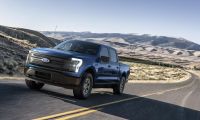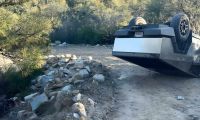Do you remember all the hubbub last week when a prototype Ford F150 EV pulled 10 railway cars loaded with 42 Ford F150s? Supposedly, the feat of a prototype EV hauling more than 1 million pounds worth of railway cars and trucks was of major significance. There were only two questions that could arise from this stunt: to whom was this stunt necessary and why was it important?
Ford F150 EV Important To P.R.
So, to who was this important: the answer is obvious, Ford PR. And, why was it necessary – bragging rights. If an electric pickup can pull over 1 million pounds of weight, by extension, the truck was capable of doing anything you might want. Ford likely had hoped for more, but, after this information from Road & Track showed up, they will probably have to scale back their accolades. They’ll have to use the data from the great train roll for towing, and that’s about it. Let’s take a look at the whole issue, starting with a bit of history and finishing up with the conclusion.
A couple of weeks ago, a story broke on the evening news from Ford about its prototype electric F150 pickup. In the runup to the actual demonstration, viewers saw a bunch of skeptical current Ford F150 owners – both old and new – who received an idea of the plans and the Ford F150 EV concept. They were supportive of the idea of an electric Ford F150. And, as they stood around discussing electric trucks, the F150 owners were startled when the pickup they had apparently assumed was a regular F150 turned out to be electric. There were several “Wows,” and other comments when a member of the Ford staff pulled off a large piece of tape covering Electric Vehicle Prototype beneath it. It was an unexpected moment and pointed out just how much planning was already going on for upcoming models. For instance, Ford plans to increase the size of the center display in 2020 models.
The plan was to load a bunch of the owners into the Ford EV Prototype where they would witness the pickup pull a few rail cars. The startled crew heard the word 10, and they waited. Meantime, with the chief engineer behind the wheel of the prototype, the F150 EV slowly started to haul the 10 empty rail carriers. A bit later, after pulling the railroad cars, they heard another plan unfold. Ford planned a second rail car pull with the Ford F150 EV. This time, though, instead of empty rail cars, the 42 Ford F150 examples, lined up next to the rail track would be loaded on the car-carriers. The total weight for this enterprise was 1.25 million pounds.
Ford F150 EV Did Strain, But Managed The Pull
It took a bit more strain on the F150 EV to get rolling, but the prototype hauled the loaded rail cars 1,000 feet. This feat convinced the skeptics in the crowd of the capability of an electric pickup. And, the chief engineer spoke to the future of the F150 EV.
With this background set, let’s take a closer look at the feat through the research of Road & Track. According to the popular automotive publication, the F150 EV did, indeed, haul all that weight, but, it looks like the deck was stacked more than a little. Indeed, the ringer here was the construction of railway cars and tracks. The key was steel.
That’s right, steel. Since the rail cars had steel wheels on their bogies and the tracks were also steel, the rail cars had very low rolling resistance, so it was relatively easy to get things moving once the F150 started forward. R&T ran the numbers and found some startling results.
Watch All-Electric F-150 Prototype Towing 1M+ Pounds and Click To Subscribe To Torque News Youtube Channel For Daily Ford and Automotive Industry News Analysis.
Ford F150 EV Pull Numbers Plugged In
After plugging the numbers into their PC systems, the publication found that it would only take about 1,875 pounds-feet of torque to get those rail cars moving. Light trucks are easily able to provide this level of force.
Road & Track explained the mathematics of the rail tow this way. It says that to reach 1,875 pounds of pulling force, you need a vehicle with traction that weighs more than 1,875 pounds. The Ford Authority weighed in over the weekend with a comment about this when it said: “We’ve seen stunts like this where heavy loads are pulled on asphalt.” If this particular stunt involved asphalt, it would require a much larger vehicle because the coefficient of rolling resistance for asphalt is about 10 times higher for a tire on asphalt than on steel. That’s the key to this whole publicity effort.
Follow Marc Stern, the Ford F150 Reporter for Torque News with news and tips about Ford trucks at @iraradioguy or on Facebook at mstern001.
The Ford Authority, Road & Track













Comments
Did you think that there was
Permalink
Did you think that there was something more going on with the recent 1.25 million pound F150 EV train pull? Let us know.
Yeah, that F150 EV story
Permalink
Yeah, that F150 EV story reminded me right away of the man who pulled a 261 Ton commuter train with his teeth! The rolling friction of steel rail car wheels is VERY low, so the toughest part is just to get it started rolling, then most any heavy vehicle with good torque and traction can keep it going. Still, the promotion is more important to me because it actually shows Ford's intention to build an EV F150, and shows that Ford has not forgotten EVs, despite their sad announcement that they are stopping the production of most of their EVs and economy cars in general. I would love to see GM and Chrysler show a similarly grand EV promotion.
Thanks Dean, while I came to
Permalink
Thanks Dean, while I came to the same conclusion as you did, I also think it shows Ford's intention to built the F150 EV and support it. And, when you think about it I agree, the whole stunt was really neat, still it did deserve a bit of explanation because you KNOW someone someday will attempt to pull at least one railcar and won't really know what to do, possible leaving his entire driveline on the ground.
This speaks to the wider idea
Permalink
This speaks to the wider idea that any major automaker putting effort into promoting their EV credentials is a positive sign. Audi ads for the eTron during the SuperBowl and placement in Avengers Endgame, for example, or the more recent VW "Drive Bigger" campaign. It doesn't mean they're suddenly competitive in the EV space, but it certainly shows an intent to build a brand there. I don't think these companies spend big money on ads and PR stunts like this just to say "we could compete if we wanted to."
None of this ever impresses
Permalink
None of this ever impresses me because its never relevant to what I would do myself with a vehicle. Give me more practical stats like range, how well does it pull a trailer or load. What is the charging requirements and how long to charge. I think we all get that electric motors by design have incredible torque from dead start. Tesla has proven this and yet means little in real world driving. Sure, I guess next time I need to move some train cars I know what to use. Otherwise, give me some real world useful facts.
When I have the facts about
Permalink
When I have the facts about torque, range, length of charge, etc, you'll have them. You make a good point.